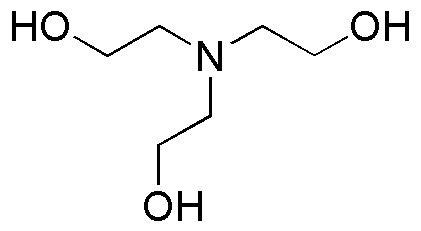Triethanolamine is widely utilized in research focused on various applications across multiple industries.
- Cosmetics and Personal Care: Commonly found in lotions, creams, and shampoos, it acts as an emulsifier and surfactant, helping to blend oil and water components for a smooth application.
- Pharmaceuticals: Used as a pH balancer and stabilizer in drug formulations, it enhances the solubility of active ingredients, improving the efficacy of medications.
- Textiles: Employed in textile processing, it serves as a softening agent and helps in dyeing processes, ensuring vibrant colors and improved fabric feel.
- Industrial Cleaning: Effective in formulating cleaning agents, it helps to remove grease and dirt from surfaces, making it valuable in manufacturing and maintenance sectors.
- Agriculture: Utilized in pesticide formulations, it enhances the spread and adhesion of active ingredients on plant surfaces, improving pest control effectiveness.
General Information
Properties
Safety and Regulations
Applications
Triethanolamine is widely utilized in research focused on various applications across multiple industries.
- Cosmetics and Personal Care: Commonly found in lotions, creams, and shampoos, it acts as an emulsifier and surfactant, helping to blend oil and water components for a smooth application.
- Pharmaceuticals: Used as a pH balancer and stabilizer in drug formulations, it enhances the solubility of active ingredients, improving the efficacy of medications.
- Textiles: Employed in textile processing, it serves as a softening agent and helps in dyeing processes, ensuring vibrant colors and improved fabric feel.
- Industrial Cleaning: Effective in formulating cleaning agents, it helps to remove grease and dirt from surfaces, making it valuable in manufacturing and maintenance sectors.
- Agriculture: Utilized in pesticide formulations, it enhances the spread and adhesion of active ingredients on plant surfaces, improving pest control effectiveness.
Documents
Safety Data Sheets (SDS)
The SDS provides comprehensive safety information on handling, storage, and disposal of the product.
Product Specification (PS)
The PS provides a comprehensive breakdown of the product’s properties, including chemical composition, physical state, purity, and storage requirements. It also details acceptable quality ranges and the product's intended applications.
Certificates of Analysis (COA)
Search for Certificates of Analysis (COA) by entering the products Lot Number. Lot and Batch Numbers can be found on a product’s label following the words ‘Lot’ or ‘Batch’.
*Catalog Number
*Lot Number
Certificates Of Origin (COO)
This COO confirms the country where the product was manufactured, and also details the materials and components used in it and whether it is derived from natural, synthetic, or other specific sources. This certificate may be required for customs, trade, and regulatory compliance.
*Catalog Number
*Lot Number
Safety Data Sheets (SDS)
The SDS provides comprehensive safety information on handling, storage, and disposal of the product.
DownloadProduct Specification (PS)
The PS provides a comprehensive breakdown of the product’s properties, including chemical composition, physical state, purity, and storage requirements. It also details acceptable quality ranges and the product's intended applications.
DownloadCertificates of Analysis (COA)
Search for Certificates of Analysis (COA) by entering the products Lot Number. Lot and Batch Numbers can be found on a product’s label following the words ‘Lot’ or ‘Batch’.
*Catalog Number
*Lot Number
Certificates Of Origin (COO)
This COO confirms the country where the product was manufactured, and also details the materials and components used in it and whether it is derived from natural, synthetic, or other specific sources. This certificate may be required for customs, trade, and regulatory compliance.


